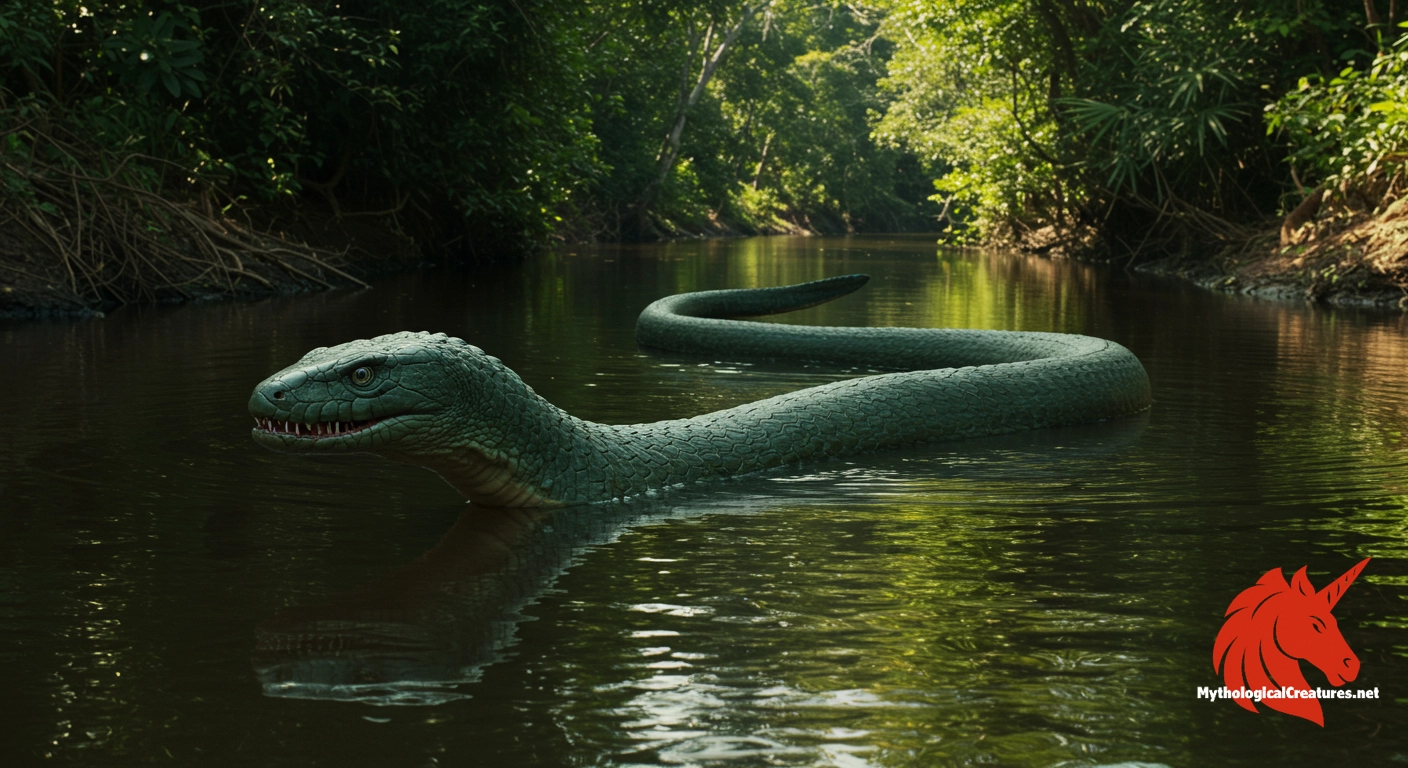Ilomba: Ilomba is a mythological sea snake created by witch doctors in Lozi folklore of Zambia.

Ilomba
Ilomba - The Ilomba embodies the dangerous consequences of meddling with dark magic in Lozi folklore, symbolising the lethal bond between creator and creation.
Origins & First Encounters
Ilomba emerges as a formidable sea snake within the rich tapestry of Lozi mythology, celebrated for its destructive yet enigmatic nature. Conceived by potent witch doctors, its creation involves a ritualistic blend of the practitioner’s own fingernails and blood, mixed with herbs believed to harbour mystical force. Its origins are steeped in secret rites, where the deliberate combination of organic elements and sorcery gives life to a creature of both terror and awe. The earliest accounts of Ilomba are preserved through oral traditions, passed down by elders in communal storytelling sessions. This myth captures the delicate balance between wielding supernatural power and facing its inevitable repercussions. The creature’s unique ability to adopt the identity of its owner accentuates themes of transformation and blurred boundaries between the human and the mystical. It serves as a vivid reminder of the ethical quandaries and responsibilities that come with engaging in forbidden magic. Ultimately, the Ilomba encapsulates a timeless narrative of creation, punishment, and the relentless interplay between human ambition and the forces of the unknown.
Source Texts & Tale Variants
Narratives of the Ilomba are primarily sustained by vibrant oral traditions among the Lozi people, where every retelling enriches its mystique. In these accounts, witch doctors are not merely healers but architects of formidable creatures, with the Ilomba standing as a testament to their dark craft. Ritual descriptions are detailed, recounting the precise use of fingernails and blood combined with potent herbs, which underscores the deliberate nature of its creation. Folkloric sessions and ritual gatherings have long been the conservatories of its myth, ensuring that the story reverberates through generations. Varying accounts inject unique details into its origin, with some versions emphasising its role as an instrument of vengeance while others portray it as an accidental by-product of mystical experimentation. The creature’s dual existence—both as a separate entity and an extension of its master—has been a subject of divergent narrative strands among storytellers. Although written records are sparse, ethnographic studies and modern transcriptions have attempted to capture these vibrant oral histories. In every retelling, the narrative of the Ilomba deepens, reflecting the communal belief in magic intertwined with human destiny.
Form & Powers
The Ilomba is portrayed with a sinuous, serpentine body that exudes an otherworldly energy, setting it apart from ordinary snakes. Its scales are said to glisten with deep hues of marine blue and emerald green, intermingled with streaks of iridescent silver that capture shifting light. In its youth, the creature's fangs are noticeably underdeveloped, symbolising a period of vulnerability before its full destructive potential is realised. As it matures, the developing fangs adopt a more menacing aspect, marking the transition from a docile state to a formidable predator. The head of the Ilomba is a paradox, bearing the deceptive semblance of normalcy while simultaneously possessing the ability to mirror the visage of its master. Faint, almost imperceptible markings and runic symbols are said to adorn its skin, remnants of the magical rites that birthed it. Its eyes, when caught in rare moments of intensity, seem to burn with an inner fire hinting at the soul-consuming power within. Overall, the physical form of the Ilomba is a striking fusion of natural serpent elegance and the eerie embellishments wrought by human magic.
Regional Faces
While the Lozi people of Zambia maintain the most celebrated accounts of the Ilomba, neighbouring communities have woven their own variations into the myth. In some regions, similar serpentine entities are recognised, each uniquely adapted to local beliefs and the natural landscapes they inhabit. Certain communities emphasise its connection with water, portraying it as a guardian spirit of rivers and seas rather than solely a tool of vengeance. Others focus on its ominous role as an arbiter of retribution, reflecting the local value placed on justice and moral balance. Regional adaptations often incorporate distinctive rituals and alternative ingredients, which subtly alter the nature and power of the creature. These variations underscore how closely the creature’s myth is tied to the environment and cultural context of different peoples. Local artists and storytellers have further enriched the Ilomba’s image by infusing additional supernatural attributes that resonate with indigenous cosmologies. Such multifaceted portrayals highlight the dynamic manner in which myth evolves across geographic and cultural boundaries while retaining an underlying essence of dark enchantment.
Cultural Parallels
The narrative of the Ilomba resonates with cross-cultural themes found in many mythological creatures fashioned through human artifice. Similar to the concept of a homunculus or golem, it is an entity crafted by human hands and steeped in mystical energy, bound to the will of its creator. Parallels can be drawn with serpentine monsters in various traditions, where the snake embodies both wisdom and the potential for catastrophic destruction. The creature’s ability to mirror its owner’s identity echoes motifs of shape-shifting and doppelgängers in European folklore. In Mediterranean myths, legends of basilisk-like creatures also combine beauty with lethal power in a form that both mesmerises and terrifies. Eastern traditions, too, feature serpentine beings that navigate the delicate balance between benevolence and menace, much like the Ilomba. This shared motif across cultures underscores a universal caution against the unchecked use of transformative powers. Within a broader mythological panorama, the Ilomba stands as an evocative symbol linking the creative impulse to the inevitable consequences of wielding dark magic.
Legacy & Modern Evolution
Over the centuries, the tale of the Ilomba has evolved from a shrouded oral myth into a complex symbol of caution and retribution in popular culture. Once solely the domain of witch doctors and secret rites, its narrative has expanded to meet modern sensibilities about the perils of dabbling in forces beyond human control. New literary works and artistic interpretations cast the Ilomba in varied lights, from a tragic by-product of magical ambition to a deliberate agent of fate. Contemporary storytellers often explore the paradox of its existence, focusing on the mutual bond that ties the creature to its master. Modern reinterpretations delve into its symbolism, reflecting on the ethical dimensions of power, responsibility, and the consequences of creation. The creature’s legacy has also found its way into academic discussions, where its myth represents a bridge connecting ancient ritual practices with contemporary cultural anxieties. Visual media and cinema have reimagined the Ilomba, blending traditional imagery with innovative special effects to evoke its eerie presence. Today, the enduring myth of the Ilomba continues to fascinate and haunt, serving as a poignant allegory about the intricate ties between creator and creation.
Interesting Fact
Despite its fearsome, destructive abilities, the Ilomba exists only through its bond with its master, highlighting a uniquely dangerous dependency in Lozi magical traditions.
Quick Creature Info
Origin:
Features:
Associations:
Our Mythic Legendary Rating:

Habitat:
Supernatural Powers:
Physical Attributes:
Abilities:
Behavior:
Weaknesses:
Lore:
Related Creatures, Tales or Lore
References
Discover Another Mythical Legend You May Not Have Heard Of?
Uncover the mysteries of ancient folklore and expand your knowledge of legendary beings from cultures around the world.
Dare to Meet the Abyzou....
Curated by the Mythological Creatures Team (rev. May 2025)
